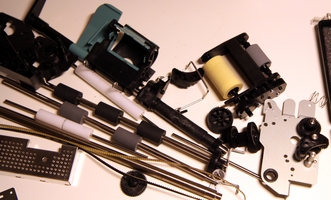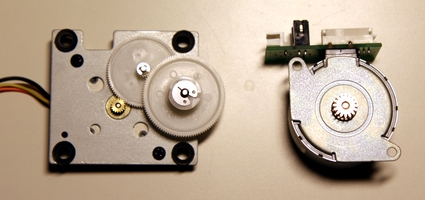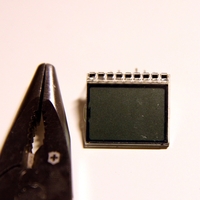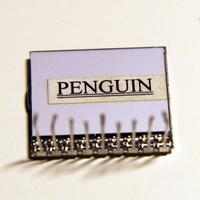Scavenging: Scanner
Why throw away things when you can keep them? Or at least get some useful parts!? :-) I recently found an old HP ScanJet 4500C which was about to be thrown away. After I had opened it and unscrewed every single screw, there was just some plastic left to get rid of. And some nice parts left for me.
The scanner included a document feeder as seen on the image above. Great, even more parts! In the end, I found two stepper motors, a two digit LCD display (with what seems to be a strange data interface), a few small IR blocking sensors, the scanning sensor, a very narrow focusing wide angle lens, lots of buttons, lots of plastic gears, and a unknown amount of screws. More details follow.
Mitsumi Stepping Motor M42SP-5
The stepping motor from the document feeder (right mote in the picture above) has the following text on its sticker:
Stepping Motor - Mitsumi M42SP-5 - 7.5° Step 3140-1093 - 10Ohm T1C2522 - Made in Taiwan
As far as I can tell from the various data sheets, it is a 24 V, 2 phase, unipolar driving stepper motor. There's a bit of discussion about whether it has 4 or 5 wires or is bi or unipolar, however it it is difficult to tell when the controller board is mounted on top. Consensus seems to be to remove that though. The torque seems quite high, so I hope I can fit it into one of my projects.
Neocene Stepper Motor 2T4242
The second motor (to the left in the picture above) was from the scanner, moving the scanning head back and forth. As can be seen from the image above, it already has two gears neatly attached. I haven't counted, however I'm guessing the gear ratio is more than 1:150 to the top gear. It has four wires coming out, and has the following on the sticker:
Neocene 2T424217 4 Ohm 22052201
The motor code number is explained on the Neocene web site. In this case, 2T indicates it is a PM-type stepper motor; 42 is the outer diameter; 4 is the step angle code; 2 is the hight code; and 17 is a serial number. It means it is 8.3 mm high, and has a step angle of 3.75. From the data sheet, it is a 12 V motor with 4 Ohm resistance. The excitation is bipolar 1-2.
Penguin LCD
From the control panel of the scanner, I got a small two digit LCD. It has 9 legs, and by applying voltage to different pairs of legs, I can turn on what seems to be predefined segments of the two digits. I guess I'll have to create the map of legs to segments, and see what I can draw. Maybe there is a more clever way to drive it. However, I don't have any specific enough search terms to go on.






